By Amos I. Root
Published in "Gleanings in Bee Culture"
January 1, 1905
For 32 years I have
been ransacking the world ― that is, so far as I could consistently ―
watching" periodicals of almost every sort, and leaving no stone
unturned to furnish information of interest and value to the readers of
Gleanings. I have especially tried to have our own journal up to date in
scientific matters; and until the past summer I have made haste to
present at once to our readers every bit of information I could get hold
of. In short, I have had no secrets whatever that I have withheld. But
for the first time in my life, during the past summer I have been under
a promise of secrecy. When the Wright brothers kindly permitted me to be
present while they were making preliminary experiments they especially
desired I should keep to myself, at least for the time being, what I
saw. 1 recognized the justice of it, and of course assented. But it was
a very hard task for me to keep my tongue ― or pen ― still when I knew
the great outside world knew so little (or nothing) of what was going
on. Scarcely a dozen people in this whole universe knew what I knew, but
I could not tell it. I have thrown out some hints, you may remember, of
what was going on. But one of the brothers suggested, “The best way to
keep a secret is to avoid letting anybody know you have a secret to
keep." We are told it is hard for women to keep a secret, and I think I
must be to some extent feminine in my make-up. Well, just before
Christmas my heart was made glad by a letter informing me that, as the
experiments for 1904 were probably ended, I might tell the world what I
knew about the flying-machine, and therefore I have been made happy.
Yes, today, Dec. 26, I am not only enjoying a happy Christmas but I feel
just like saying, “A merry and a happy Christmas to you all." I hope you
will enjoy my story about the flying-machine ― as much as I enjoyed
being out in that big field with the Wright brothers many times during
the past summer and fall, watching that wonderful creation of the hand
and brain of those two men, while it "learned to fly," very much as a
young bird just out of the nest learns by practice to use its wings. A
picture of the flying-machine up in the air will appear in our next
issue, nothing preventing. We could not get it ready for this one.
What hath God wrought ― Num. 23:23.
 ear
friends, I have a wonderful story to tell you ― a story that, in some
respects, out-rivals the Arabian Nights fables ― a story, too, with a
moral that I think many of the younger ones need, and perhaps some of
the older ones too if they will heed it. God in his great mercy has
permitted me to be, at least somewhat, instrumental in ushering in and
introducing to the great wide world an invention that may outrank the
electric cars, the automobiles, and all other methods of travel, and one
which may fairly take a place beside the telephone and wireless
telegraphy. Am I claiming a good deal? Well, I will tell my story, and
you shall be the judge. In order to make the story a helpful one I may
stop and turn aside a good many times to point a moral. ear
friends, I have a wonderful story to tell you ― a story that, in some
respects, out-rivals the Arabian Nights fables ― a story, too, with a
moral that I think many of the younger ones need, and perhaps some of
the older ones too if they will heed it. God in his great mercy has
permitted me to be, at least somewhat, instrumental in ushering in and
introducing to the great wide world an invention that may outrank the
electric cars, the automobiles, and all other methods of travel, and one
which may fairly take a place beside the telephone and wireless
telegraphy. Am I claiming a good deal? Well, I will tell my story, and
you shall be the judge. In order to make the story a helpful one I may
stop and turn aside a good many times to point a moral.
In our issue for Sept. 1 I told you
of two young men, two farmer's boys, who love machinery, down in the
central part of Ohio. I am now going to tell you something of two other
boys, a minister's boys, who love machinery, and who are interested in
the modern developments of science and art. Their names are Orville and
Wilbur Wright, of Dayton, Ohio. I made mention of them and their work on
page 241 of our issue for March 1 last. You may remember it. These two,
perhaps by accident, or may be as a matter of taste, began studying the
flights of birds and insects. From this they turned their attention to
what has been done in the way of enabling men to fly. They not only
studied nature, but they procured the best books, and I think I may say
all the papers, the world contains on this subject. When I first became
acquainted with them, and expressed a wish to read up all there was on
the subject, they showed me a library that astonished me ; and I soon
found they were thoroughly versed, not only in regard to our present
knowledge, but every thing that had been done in the past. These boys
(they are men now), instead of spending their summer vacation with
crowds, and with such crowds as are often questionable, as so many do,
went away by themselves to a desert place by the seacoast. You and I
have in years past found enjoyment and health in sliding down hills on
the snow ; but these boys went off to that sandy waste on the Atlantic
coast to slide down hills too; but instead of sliding on snow and ice
they slid on air. With a gliding machine made of sticks and cloth they
learned to glide and soar from the top of a hill to the bottom ; and by
making not only hundreds but more than a thousand experiments, they
became so proficient in guiding these gliding machines that they could
sail like a bird, and control its movements up and down as well as
sidewise. Now, this was not altogether for fun or boys' play.* They
had a purpose in view. I want to stop right here to draw one of my
morals. If I allude to myself somewhat, please do not think I do it
because I wish to boast. Some of you have read or heard me tell of the
time when my attention was first called to bees. Almost the first thing
I did was to go to the bookstores and see what books were to be found on
the subject. I studied these books day and night, and read them over and
over again. Then I procured the books and bee-journals from the old
world; and when the language was something I could not manage I hired an
interpreter to translate for me until I knew pretty nearly what the book
contained. In less than one year I was in touch with the progressive
bee-keepers of the world; and the American Bee Journal, that had been
dropped for lack of support, was started up again. I mention this to
show you that my success in bee culture, from the very first, was not
luck or chance. It was the result of untiring energy and work. Now let
me draw a contrast. During the years that are past, quite a number of
men have come to me with their patented hives. A good many of these men
had never seen a bee-journal. Some of them who had paid out their hard
earnings to the Patent Office had almost never seen a book on bee
culture, and they were not sure, from actual experience, of the
existence of the queen-bee. We have inventors at the present time who
are giving their lives and money to the four winds in the same poor
foolish way. If you wish to make a success of any thing, or in any line
among the many lines that lie before us in this great world of ours,
find out what the great and good men have done in this special line
before you.
Well, these two men spent several
summers in that wild place, secure from intrusion, with their gliding
machine. When they became experts they brought in, as they had planned
to do, a gasoline-engine to furnish power, and made a little success
with their apparatus before winter set. As soon as the weather would
permit, their experiments were resumed the past season. You may have
seen something in regard to it in the papers ; but as their purpose has
been from the beginning to the end to avoid publicity, the great
outside world has had but very little opportunity of knowing what is
going on. The conditions were so different after applying power that it
seemed at first, to a great extent, as if they would have to learn the
trade of guiding their little ship all over again. At first they went
only a few hundred feet; and as the opportunity for practice in guiding
and controlling it was only a few seconds at a time, their progress was
necessarily very slow. Let me digress again just a little.
I do not know exactly how many years
ago it was, perhaps something like thirty, that I saw in the Scientific
American that they had in France what was called at that time a
velocipede. As soon as I saw the description I sent an order for one,
and I think I had about the first machine in the semblance of a bicycle
that was ever in Ohio ― perhaps one of the first brought into the United
States. The machine cost over $100; and as it was a heavy affair, the
express on it cost quite an item more. When it came to hand, after days
and weeks of anxious waiting, neither myself nor anybody else could ride
it at all. The whole town jeered at me, and the story of the "fool and
his money" was hurled in my teeth so many times I almost dread to hear
it even yet. Men of good faith understanding pointed their fingers at
me, and said that anybody of good common sense ought to know that that
thing would not stand up with a man on it, for that would be an utter
impossibility. I worked at it, the crowd in my way, for several hours in
the morning. Finally I rented the largest hall in the town, went in with
one trusty boy who had faith, for a companion, and locked the door.
After quite a little practice on the smooth floor of the hall I
succeeded in riding from one end to the other ; but I could not turn the
corners. When, after still more practice, I did turn one corner without
falling, how my spirits arose ! A little later I went in a wabbly way
clear around the room. Then my companion did the same thing, and, oh how
we did rejoice and gather faith ! A little later on, with a flushed but
happy face, I went out into the street and rode around the public
square. You can guess the rest of it. Well, these boys wanted just the
same kind of privacy to try their flying-machine that I needed for my
velocipede; but as it measures about forty feet from the tip of one wing
to the tip of the other, instead of a large hall they wanted a large
level field in some out-of-the-way place. I found them in a pasture lot
of 87 acres, a little over half a mile long and nearly as broad. The few
people who occasionally got a glimpse of the experiments, evidently
considered it only another Darius Green, but I recognized at once they
were really scientific explorers who were serving the world in much the
same way that Columbus did when he discovered America, and just the same
way that Edison, Marconi, and a host of others have done all along
through the ages.
In running an automobile or a
bicycle you have to manage the steering only to the right and left; but
an air-ship has to be steered up and down also. When I first saw the
apparatus it persisted in going up and down like the waves of the sea.
Sometimes it would dig its nose in the dirt, almost in spite of the
engineer. After repeated experiments it was finally cured of its foolish
tricks, and was made to go like a steady old horse. This work, mind you,
was all new. Nobody living could give them any advice. It was like
exploring a new and unknown domain. Shall I tell you how they cured it
of bobbing up and down? Simply by loading its nose or front
steering-apparatus with cast iron. In my ignorance I thought the engine
was not large enough; but when fifty pounds of iron was fastened to its
"nose " (as I will persist in calling it), it came down to a tolerably
straight line and carried the burden with ease. There was a reason for
this that I can not explain here. Other experiments had to be made in
turning from right to left; and, to make the matter short, it was my
privilege, on the 20th day of September, 1904, to see the first
successful trip of an airship, without a balloon to sustain it, that the
world has ever made, that is, to turn the corners and come back to the
starting-point. During all of these experiments they have kept so near
the soft marshy ground that a fall would be no serious accident, either
to the machine or its occupant. In fact, so carefully have they managed,
that, during these years of experimenting, nothing has happened to do
any serious damage to the machine nor to give the boys more than what
might be called a severe scratch. I think great praise is due them along
this very line. They have been prudent and cautious. I told you there
was not another machine equal to such a task as I have mentioned, on the
face of the earth; and, furthermore, just now as I dictate there is
probably not another man besides these two who has learned the trick of
controlling it. In making this last trip of rounding the circle, the
machine was kept near the ground, except in making the turns. If you
will watch a large bird when it swings around in a circle you will see
its wings are tipped up at an incline. This machine must follow the same
rule ; and to clear the tip of the inside wing it was found necessary to
rise to a height of perhaps 20 or 25 feet. When the engine is shut off,
the apparatus glides to the ground very quietly, and alights on
something much like a pair of light sled-runners, sliding over the
grassy surface perhaps a rod or more. Whenever it is necessary to slow
up the speed before alighting, you turn the nose up hill. It will then
climb right up on the air until the momentum is exhausted, when, by
skillful management, it can be dropped as lightly as a feather.
Since the above was written they
have twice succeeded in making four complete circles without alighting,
each circle passing the starting-point. These circles are nearly a mile
in circumference each; and the last flight made, Dec. 1, could have been
prolonged indefinitely had it not been that the rudder was in such
position it cramped the hand of the operator so he was obliged to
alight. The longest flight took only five minutes and four seconds by
the watch. Over one hundred flights have been made during the past
summer. Some of them reached perhaps 50 or 60 feet above ground. On both
these long trips seventy pounds instead of fifty of cast iron was
carried on the "nose."
Everybody is ready to say, "Well,
what use is it ? what good will it do ?" These are questions no man can
answer as yet. However, I will give you a suggestion or two. The man who
made this last trip said there was no difficulty whatever in going above
the trees or anywhere he chose; but perhaps wisdom would dictate he
should have still more experience a little nearer the ground. The
machine easily made thirty or forty miles an hour, and this in going
only a little more than half a mile straight ahead. No doubt it would
get up a greater speed if allowed to do so ― perhaps, with the wind, a
mile a minute after the first mile. The manager could doubtless go
outside of the field and bring it back safely, to be put in the little
house where it is kept nights. But no matter how much time it takes, I
am sure all the world will commend the policy so far pursued ― go slowly
and carefully, and avoid any risk that might cause the loss of a human
life. This great progressive world can not afford to take the risk of
losing the life of either of these two men.*
I have suggested before, friends,
that the time may be near at hand when we shall not need to fuss with
good roads nor railway tracks, bridges, etc., at such an enormous
expense. With these machines we can bid adieu to all these things. God's
free air, that extends all over the earth, and perhaps miles above us,
is our training field. Rubber tires, and the price of rubber, are no
longer "in it." The thousand and one parts of the automobile that go to
make its construction, and to give it strength, can all be dispensed
with. You can set your basket of eggs almost anywhere on the upper or
lower deck, they will not even rattle unless it be when they come to
alight. There are hundreds of queer things coming to light in regard to
this new method of travel; and I confess it is not clear to me, even
yet, how that little aluminum engine, with four paddles, does the work.
I asked the question, "Boys, would that engine and these two propellers
raise the machine from the ground if placed horizontally above it ? "
"Certainly not, Mr. Root. They would
not lift a quarter of its weight."
" Then how is it possible that it
sustains it in the air as it is ? "
The answer involves a strange point
in the wonderful discovery of air navigation. When some large bird or
butterfly is soaring with motionless wings, a very little power from
behind will keep it moving. Well, if this motion is kept up, a very
little incline of the wings will keep it from falling. A little more
incline, and a little more push from behind, and the bird or the
butterfly, or the machine created by human hands, will gradually use in
the air. I was surprised at the speed, and I was astonished at the
wonderful lifting power of this comparatively small apparatus. When I
saw it pick up the fifty pounds of iron so readily I asked if I might
ride in place of the iron. I received, by way of assurance, the answer
that the machine would no doubt carry me easily. You see then I would
have the "front seat;" and even if it is customary (or used to be in
olden times) to accord the front seat to the ladies, I think the greater
part of them would say, " Oh! sit still, Mr. Root. Do not think of
getting up to give us your seat."
At first there was considerable
trouble about getting the machine up in the air and the engine well up
to speed. They did this by running along a single-rail track perhaps 200
feet long. It was also, in the early experiments, found advisable to run
against the wind, because they could then have a greater time to
practice in the air and not get so far away from the building where it
was stored. Since they can come around to the starting-point, however,
they can start with the wind even behind them; and with a strong wind
behind it is an easy matter to make even more than a mile a minute. The
operator takes his place lying flat on his face. This position offers
less resistance to the wind. The engine is started and got up to speed.
The machine is held until ready to start by a sort of trap to be sprung
when all is ready; then with a tremendous flapping and snapping of the
four-cylinder engine, the huge machine springs aloft. When it first
turned that circle, and came near the starting-point, I was right in
front it; and I said then, and I believe still, it was one of the
grandest sights, if not the grandest sight, of my life. Imagine a
locomotive that has left its track, and is climbing up in the air right
toward you ― a locomotive without any wheels, we will say, but with
white wings instead, we will further say ― a locomotive made of
aluminum. Well, now, imagine this white locomotive, with wings that
spread 20 feet each way, coming right toward you with a tremendous flap
of its propellers, and you will have something like what I saw. The
younger brother bade me move to one side for fear it might come down
suddenly; but I tell you, friends, the sensation that one feels in such
a crisis is something hard to describe. The attendant at one time, when
the rope came off that started it, said he was shaking from head to foot
as if he had a fit of ague. His shaking was uncalled for, however, for
the intrepid manager succeeded in righting up his craft, and she made
one of her very best flights. I may add, however, that the apparatus is
secured by patents, both in this and in foreign countries; and as nobody
else has as yet succeeded in doing any thing like what they have done I
hope no millionaire or syndicate will try to rob them of the invention
or laurels they have so fairly and honestly earned.
When Columbus discovered America he
did not know what the outcome would be, and no one at that time knew;
and I doubt if the wildest enthusiast caught a glimpse of what really
did come from his discovery. In a like manner these two brothers have
probably not even a faint glimpse of what their discovery is going to
bring to the children of men. No one living can give a guess of what is
coming along this line, much better than any one living could conjecture
the final outcome of Columbus' experiment when he pushed off through the
trackless waters. Possibly we may be able to fly over the north pole,
even if we should not succeed in tacking the "stars and stripes" to its
uppermost end.
|
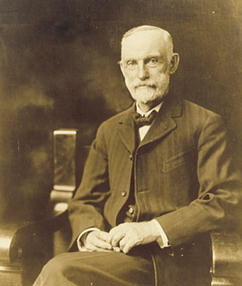
Amos Ives Root was the founder of A.I. Root & Company of Medina, Ohio,
one of the largest manufacturers of beekeeping equipment in America. He
was also a highly-regarded inventor whose innovations revolutionized
beekeeping and enabled it to develop as an industry.
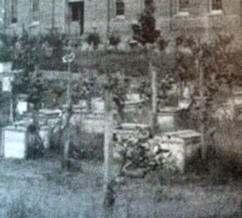
Some of Root's beehives outside his factory. This wasn't his only
interest; Root was an enthusiastic technophile who had contributed
articles to Scientific American
on a variety of subjects. Apparently, he had read about the Wrights
after their 1903 flights and asked to meet them. To visit the brothers
at Huffman Prairie, he drove an automobile, an Oldsmobile Runabout, 200 miles (322 kilometers) from Medina
― no
small feat in 1904.
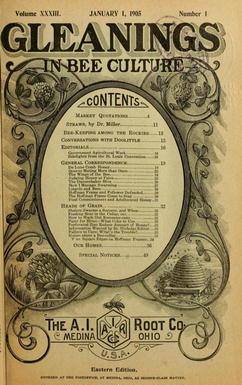
The cover of "Gleaning in Bee Culture" from 1 January 1905.
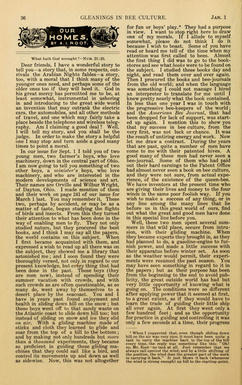
Page 36.
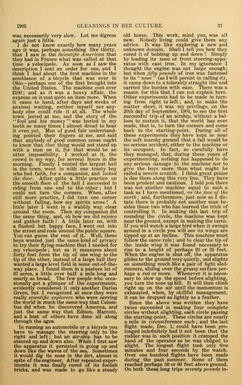
Page 37.
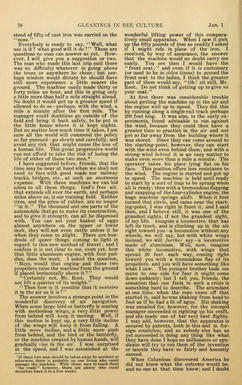
Page 38
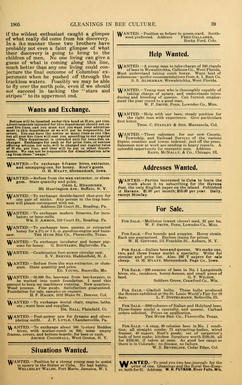
Page 39
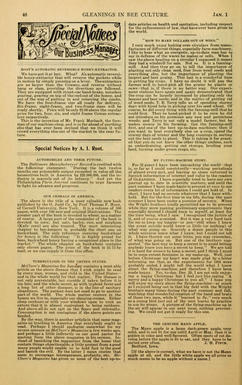
Page 48.
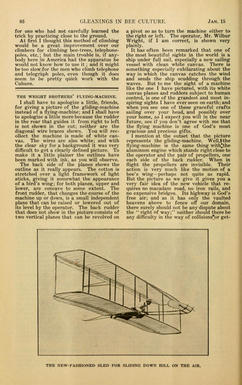
Page 86 of "Gleanings in Bee Culture," January 15, 1905. In this issue,
Root published the photo he had promised of a Wright brothers aircraft.
Apparently, the Wrights were not willing to let him publish a photo of
their powered airplane, but furnished a photo of their glider.
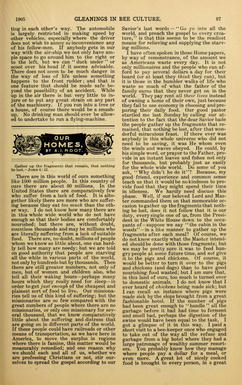
Page 87.
|